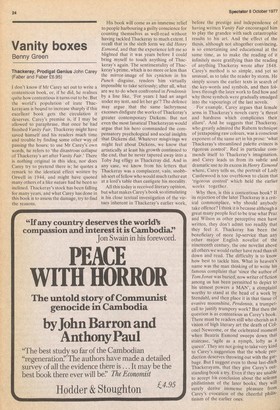Vanity boxes
Benny Green
Thackeray, Prodigal Genius John Carey (Faber and Faber £6.95) I don't know if Mr Carey set out to write a contentious book, or, if he did, he realises quite how contentious it turns out to be. But the world's population of irate Thackerayans is bound to increase sharply if this excellent book gets the circulation it deserves. Carey's premise is, if I may be allowed to paraphrase, that once he had finished Vanity Fair, Thackeray might have saved himself and his readers much time and trouble by finding some other way, of passing, the hours; to use Mr Carey's own words, he refers to 'the disastrous collapse of Thackeray's art after Vanity Fair.' There is nothing original in this idea, nor does Carey try to pretend there is; he quotes a remark to the identical effect written by Orwell in 1944, and might have quoted many others of a like nature had he been so inclined. Thackeray's stock has been falling for many years, and what Carey has done in this book is to assess the damage, try to find the reasons. His book will come as an immense relief to people harbouring a guilty conscience for counting themselves as well-read without having tackled Thackeray to much extent. I recall that in the sixth form we did Henry Esmond, and that the experience left me so blighted that it was years before 1 could bring myself to touch anything of Thackeray's again. The sentimentality of Thackeray's prime, which is no more or less than the mirror-image of his cynicism in his Punch disguise, renders him virtually impossible to take seriously; after all, what are we to do when confronted in Pendennis by a line like, 'For years I had an angel under my tent, and let her go'? The defence may argue that the same lachrymose excesses disfigure the works of Thackeray's greater contemporary Dickens. But not even the most fanatical Thackerayan would argue that his hero commanded the compensatory psychological and social insights that Dickens did. Whatever misgivings we might feel about Dickens, we know that artistically at least his growth continued to the end, that he never tapered away into a Toby Jug effigy as Thackeray did. And in any case, we know from his letters that Thackeray was a complacent, vain, snobbish sort of fellow who would much rather eat at a lord's table than castigate his morality.
All this today is received literary opinion, but what makes Carey's book so stimulating is his close textual investigation of the virtues inherent in Thackeray's earlier work,
before the prestige and independence of having written Vanity Fair encouraged him to play the grandee with such catastrophic results to his art.• And the effect of the thesis, although not altogether convincing, is so entertaining and educational at the same time, as to make the reading of it infinitely more gratifying than the reading of anything Thackeray wrote after 1848. Carey's method is so simple, and yet so unusual, as to take the reader by storm. He simply scours the earlier texts in search of the key-words and symbols, and then follows through the later work to find how and why those symbols were gradually smudged into the vapourings of the last novels.
For example, Carey argues that female arms in Thackeray's novels carry 'a threat and hardness which complicates their allure'. And he suggests that Thackeray, who greatly admired the Rubens technique of juxtaposing raw colours, was a conscious exponent of the same art in his prose: 'what Thackeray's streamlined palette evinces is rigorous control'. Red in particular commends itself to Thackeray's imagination, and Carey leads us from its subtle and dramatic use to its excess in Henry Esmond where, Carey tells us, the portrait of Lady Castlewood is too overblown to claim that 'rigorous control' which held the earlier works together.
Why then, is this a contentious book? If its rejection of the later Thackeray is a critical commonplace, why should anybody take offence? I think it is because although a great many people feel to be true what Praz and Wilson as other perceptive men have written, they don't admit too readily that they feel it. Thackeray has been the beneficiary of more lip-service than any other major English novelist of the nineteenth century, the one novelist above all others we would rather have read than sit down and read. The difficulty is to know how best to tackle him. What in heaven's name was the man thinking of to write his famous complaint that 'since the author of Tom Jones was buried, now writer of fiction among us has been permitted to depict to his utmost powers a MAN', a complaint worthy to stand at the head of a work by Stendahl, and then place it in that tissue of evasive moonshine, Pendennis, a trumpetcall to justify trumpery work? But then the question is as contentious as Carey's book. There must be readers still who cherish as a vision of high literary art the death of Colonel Newcome, or the celebrated moment when Beatrix Esmond sweeps down that staircase, 'agile as a nymph, lofty as a queen'. They are not going to take very kind to Carey's suggestion that the whole production deserves throwing out with the garbage. But I suggest even to those last-ditch Thackerayans, that they give Carey's outstanding book a try, Even if they are unable to accept his conclusion about the solemn philistinism of the later books, they vv111 surely derive immense pleasure from Carey's evocation of the cheerful phillatinism of the earlier ones,


































 Previous page
Previous page